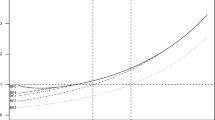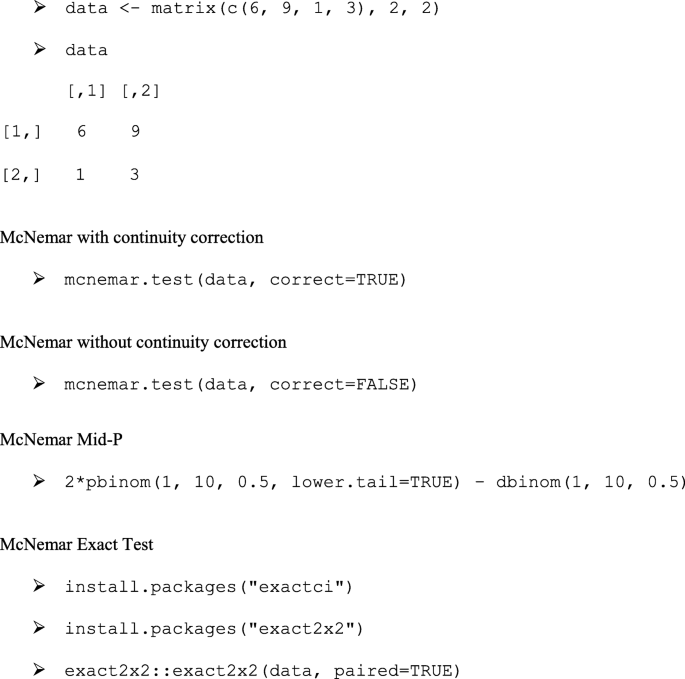
It is not uncommon for researchers to want to interrogate paired binomial data. For example, researchers may want to compare an organism’s response (positive or negative) to two different stimuli. If they apply both stimuli to a sample of individuals, it would be natural to present the data in a 2 × 2 table. There would be two cells with concordant results (the frequency of individuals which responded positively or negatively to both stimuli) and two cells with discordant results (the frequency of individuals who responded positively to one stimulus, but negatively to the other). The key issue is whether the totals in the two discordant cells are sufficiently different to suggest that the stimuli trigger different reactions. In terms of the null hypothesis testing paradigm, this would translate as a P value which is the probability of seeing the observed difference in these two values or a more extreme difference if the two stimuli produced an identical reaction. The statistical test designed to provide this P value is the McNemar test. Here, we seek to promote greater and better use of the McNemar test. To achieve this, we fully describe a range of circumstances within biological research where it can be effectively applied, describe the different variants of the test that exist, explain how these variants can be accessed in R, and offer guidance on which of these variants to adopt. To support our arguments, we highlight key recent methodological advances and compare these with a novel survey of current usage of the test.
When analysing paired binomial data, researchers appear to reflexively apply a chi-squared test, with the McNemar test being largely overlooked, despite it often being more appropriate. As these tests evaluate a different null hypothesis, selecting the appropriate test is essential for effective analysis. When using the McNemar test, there are four methods that can be applied. Recent advice has outlined clear guidelines on which method should be used. By conducting a survey, we provide support for these guidelines, but identify that the method chosen in publications is rarely specified or the most appropriate. Our study provides clear guidance on which method researchers should select and highlights examples of when this test should be used and how it can be implemented easily to improve future research.


Avoid common mistakes on your manuscript.
When analysing paired binomial data using a 2 × 2 contingency table, either the McNemar test or the chi-squared test could be applied. Although application of the latter is more common, the McNemar test is frequently more appropriate. The null hypothesis of the chi-squared test is that the two categorical variables being tested are independent. In contrast, the null hypothesis of the McNemar test is ‘marginal homogeneity’ in that the row and column marginal frequencies are equal. As these hypotheses test different questions, selecting the appropriate test is paramount for accurate analysis.
Consider an example where a number of chimpanzees are tested to see whether they can extract food from two puzzle boxes A and B (Example dataset: Table 1).

Comparison of real datasets with the simulations of Fagerland et al. (2013, 2014)
Fagerland et al. (2013, 2014) define a test situation in terms of N matched pairs of two binomial events that might each be a success or failure. They define not just N but the overall probabilities of a success in the two events (denoted P1+ and P + 1) and the overall odds ratio (denoted θ). N and the other three parameters estimated for each of our 50 datasets were obtained from the literature; this is done in Table 5 (although sometimes, the odds ratio is undefined for cases with low sample sizes). In terms of type I error rate, Fagerland et al. (2013) consider N values from 10, 15, … 100; and value of 1, 2, 3, 4…100 in terms of power. In our suite of 50 datasets, one was below this range (N = 6) and five where above it. Many researchers would not have carried out a statistical test with a total sample size of 6 due to concerns about low power. Both power and adherence to the nominal type I error rate improved with sample size. Subsequently, in terms of sample size, the values chosen by Fagerland et al. (2013) are in good accord with our suite of real datasets. They used odds ratios of 1, 2, 3, 5, and 10 for both their power and type I error simulations: only three of estimated odds ratios were greater than 10, and the results in both papers suggest that performance is not strongly affected by the value of odds ratio. For type I error rate, the two probabilities take the same value, and Fagerland et al. (2013, 2014) investigate all values 0, 0.01, 0.02, … 1.0. The rank relative performance of the different methods seems insensitive to the value chosen, and the type I error rate of the preferred mid-P method strayed from the nominal level only when the sample size was low (N 25), and the probabilities were either less than 0.1 or more than 0.9. In only one of our 50 datasets was the mean of the two estimated probabilities this extreme, and in that case, the sample size was over 100.
Table 5 Reference numbers are identical to Table 1. N is the total sample size: a + b + c + d in Table 1. Odds is as estimate of the odds ratio: (ad)/(cd). P1+ and P + 1 are estimates of the two probabilities of ‘success’: (a + b)/N and (a + c)/N respectively
Open Access This article is licensed under a Creative Commons Attribution 4.0 International License, which permits use, sharing, adaptation, distribution and reproduction in any medium or format, as long as you give appropriate credit to the original author(s) and the source, provide a link to the Creative Commons licence, and indicate if changes were made. The images or other third party material in this article are included in the article's Creative Commons licence, unless indicated otherwise in a credit line to the material. If material is not included in the article's Creative Commons licence and your intended use is not permitted by statutory regulation or exceeds the permitted use, you will need to obtain permission directly from the copyright holder. To view a copy of this licence, visit http://creativecommons.org/licenses/by/4.0/.
Pembury Smith, M.Q.R., Ruxton, G.D. Effective use of the McNemar test. Behav Ecol Sociobiol 74, 133 (2020). https://doi.org/10.1007/s00265-020-02916-y
Anyone you share the following link with will be able to read this content:
Get shareable link
Sorry, a shareable link is not currently available for this article.
Copy to clipboard
Provided by the Springer Nature SharedIt content-sharing initiative